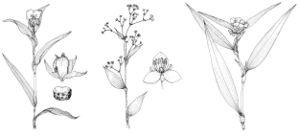Difference between revisions of "Gibasis pellucida"
Kew Bull. 38: 132. 1983.
FNA>Volume Importer |
imported>Volume Importer |
||
| (One intermediate revision by the same user not shown) | |||
| Line 8: | Line 8: | ||
}} | }} | ||
|common_names=Tahitian bridal-veil | |common_names=Tahitian bridal-veil | ||
| + | |special_status={{Treatment/ID/Special_status | ||
| + | |code=I | ||
| + | |label=Introduced | ||
| + | }}{{Treatment/ID/Special_status | ||
| + | |code=F | ||
| + | |label=Illustrated | ||
| + | }} | ||
|basionyms={{Treatment/ID/Basionym | |basionyms={{Treatment/ID/Basionym | ||
|name=Tradescantia pellucida | |name=Tradescantia pellucida | ||
| Line 33: | Line 40: | ||
|habitat=Weedy in citrus groves and waste places | |habitat=Weedy in citrus groves and waste places | ||
|distribution=Fla.;native;Mexico. | |distribution=Fla.;native;Mexico. | ||
| + | |introduced=true | ||
|discussion=<p><i>Gibasis pellucida</i> has often been confused with G. geniculata, the only other commonly cultivated species; the leaves of G. geniculata are more pubescent, however, and its filaments are bearded only at the base. For about 10 years <i>G. pellucida</i> was known as G. schiedeana.</p><!-- | |discussion=<p><i>Gibasis pellucida</i> has often been confused with G. geniculata, the only other commonly cultivated species; the leaves of G. geniculata are more pubescent, however, and its filaments are bearded only at the base. For about 10 years <i>G. pellucida</i> was known as G. schiedeana.</p><!-- | ||
--><p>Aneilema linearis (Bentham) Woodson, a species of <i>Gibasis</i>, was reported as occurring in Mexico just south of the Big Bend region of Texas (L. H. Shinners 1962). That species is likely to be G. venustula (Kunth) D. R. Hunt (D. R. Hunt 1986c). No specimens have been seen from the United States.</p> | --><p>Aneilema linearis (Bentham) Woodson, a species of <i>Gibasis</i>, was reported as occurring in Mexico just south of the Big Bend region of Texas (L. H. Shinners 1962). That species is likely to be G. venustula (Kunth) D. R. Hunt (D. R. Hunt 1986c). No specimens have been seen from the United States.</p> | ||
| Line 56: | Line 64: | ||
|publication title=Kew Bull. | |publication title=Kew Bull. | ||
|publication year=1983 | |publication year=1983 | ||
| − | |special status= | + | |special status=Introduced;Illustrated |
| − | |source xml=https:// | + | |source xml=https://bitbucket.org/aafc-mbb/fna-data-curation/src/2e0870ddd59836b60bcf96646a41e87ea5a5943a/coarse_grained_fna_xml/V22/V22_155.xml |
|genus=Gibasis | |genus=Gibasis | ||
|species=Gibasis pellucida | |species=Gibasis pellucida | ||
Latest revision as of 21:29, 5 November 2020
Herbs, perennial, decumbent. Leaves 2-ranked, blade lanceolate-oblong, 4.5–7 cm × 1.4–2.3 cm. Inflorescences terminal and distally axillary, pairs of pedunculate cymes in compound inflorescences; peduncles of cymes 1.7–2.5 cm; bracteoles overlapping. Flowers: sepals keeled, 2.5–3 mm, glabrous; petals white, 4 mm; filaments bearded at base and distal to middle. Capsules ovoid, 2.5 mm. Seeds light brown, 1 mm, rugose. 2n = 10, 16 (Mexico).
Phenology: Fruiting fall.
Habitat: Weedy in citrus groves and waste places
Distribution

Introduced; Fla., native, Mexico.
Discussion
Gibasis pellucida has often been confused with G. geniculata, the only other commonly cultivated species; the leaves of G. geniculata are more pubescent, however, and its filaments are bearded only at the base. For about 10 years G. pellucida was known as G. schiedeana.
Aneilema linearis (Bentham) Woodson, a species of Gibasis, was reported as occurring in Mexico just south of the Big Bend region of Texas (L. H. Shinners 1962). That species is likely to be G. venustula (Kunth) D. R. Hunt (D. R. Hunt 1986c). No specimens have been seen from the United States.
Selected References
None.
